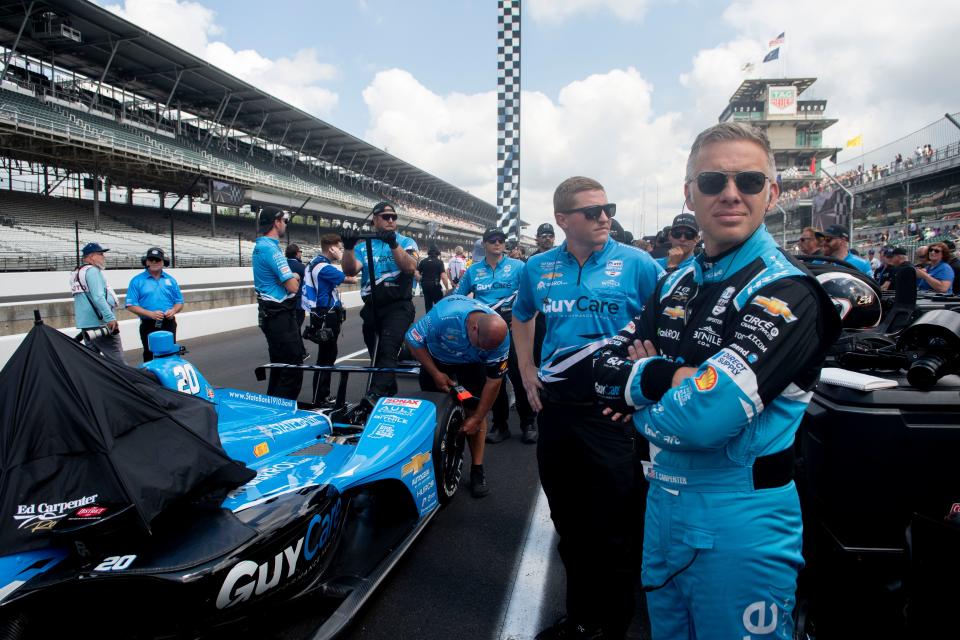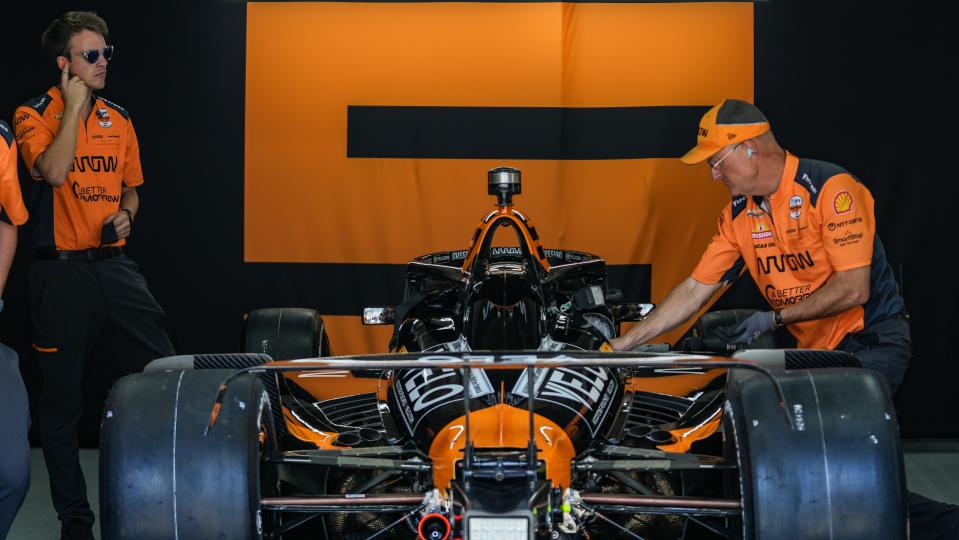What is a plenum event? Inside the glitch that hampered Chevy drivers in Day 1 of Indy 500 qualifying
INDIANAPOLIS – After four consecutive Mays of watching Honda-powered teams win the pole for the Indianapolis 500 – and three of those races ending with Honda victories – Chevrolet came into this year’s edition of the Greatest Spectacle in Racing with as much confidence as ever.
And yet, with nine of the 12 drivers that will compete for Sunday’s pole and all 16 of their entries safely in starting spots, a cloud hangs over the bowtie brand after a series of technical glitches characterized as brief engine hiccups that happened half-a-dozen times over the course of Saturday’s nearly seven hour of qualifying action at the Indianapolis Motor Speedway.
An issue that can both be random, but seemingly was a trend across nearly all of Chevy’s six teams, and it’s one Chevy employees across the globe will work through Saturday night to try and rectify, said Jim Campbell, the vice president of performance and motorsports for General Motors.

“The good news is there was no harm to any engines, but we obviously put those drivers at a deficit when they were trying to make their four fastest laps, so our team is going to work overnight running dyno facilities around the world to find ways to eliminate and mitigate those issues tomorrow around controls and calibration,” Campbell said. “We do have teams in different parts of the world that will be running, as well as our team here, pouring through the data.
“We’ve got to be ready for tomorrow. The performance is there in the engines, but we did put some pressure on some drivers that were making some great runs. That’s on us. We’ve got to make sure we’re ready to go tomorrow.”
What is a plenum event?
In laymen’s terms, plenum events often happen while drivers are shifting, which of course isn’t often across four laps at IMS, but does occur – going up and down between 5th and 6th gear – depending on the team and engine manufacturer. When a shift isn’t executed perfectly – and especially when engines are given an additional 100 horsepower for qualifying weekend – these plenum events can be more common than normal.
“Our engines are being operated on a knife’s edge this weekend, and we’re looking for every bit of performance,” Chevy’s IndyCar program manager Rob Buckner said Saturday. “On top of the cylinder heads in the air inlet system of the engine is a plenum and some fuel injectors. While these engines are sustaining high speeds, that plenum is very full of fuel.
“If we have an event over a downshift, it can ignite that fuel and evaporate the plenum of its fuel air charge. Temperatures then rise rapidly, and to the driver, it’s a perceived engine kill. (Plenum events) vary in duration and severity, and unfortunately here today, the ones were very noticeable to the driver, though anything around Indy is very noticeable to the drivers. You pretty much have to scrap those runs, which we really hate.”
Though they don’t always happen in shifting, Buckner said all six Saturday did, and they often occurred early in a run. Larson’s was the first to occur and actually took place halfway through Lap 4 of his initial run. Not knowing what his car was experiencing and seeing worrisome flashing lights and a loss of power, Larson darted onto the warmup lane and essentially called off his run.
Typically to fix a plenum event, drivers need only to take their foot off the gas for just a second, and then press back down to get the engine to reboot. But at IMS and the 500, where fractions of a second over 10 miles make the difference between dominant and average runs, even that can derail an entire qualifying weekend.
What to know about Indy 500 qualifying: Plenum events, Penske domination, heroic late runs
What Chevy drivers and teams were affected?
For many fans, the term ‘plenum event’ may have been new when it happened to Pato O’Ward while leading the Grand Prix of St. Pete in the closing laps in 2023. With the misfire, where he essentially briefly lost power until his engine returned to normal, O’Ward lost the lead – and essentially the win – to Marcus Ericsson.
In some ways, those same events Saturday were just as tragic. Occurring to six drivers across four teams – O’Ward and Larson (Arrow McLaren), Ed Carpenter and Christian Rasmussen (Ed Carpenter Racing), Conor Daly (Dreyer and Reinbold Racing) and Agustin Canapino (Juncos Hollinger Racing) – most of them looked to be on potential Fast 12-level runs late in the day Saturday from outside the top-15 when they occurred. Only the Arrow McLaren duo had time to regroup from the glitch and stay alive for pole come Sunday.
'It’s gonna be high pressure': Ericsson, Rahal, Coyne compete for final spots in Indy 500
Why did these happen Saturday?
Though Buckner and Campbell said they were surprised and disappointed in the engine issues that cropped up across the board, they noted issues like these can crop up when teams are pushing things to the limit. That teams and manufacturers are in Year 13 of this engine formula only further intensifies the search for minuscule advantages and the extremes they’ll go to to achieve them.
“I think the engine wars are unique. When we see the drivers pushing each other, it’s easy to see their fast hands and reactions, but these engine programs are behind a wall, and we’re competing out of the public eye,” Buckner said. “This is all due to how hard we have to operate and push them, and the development paths you have to take to get that performance.
“We take tremendous pride and responsibility in showing up here with a great engine program. We definitely have the power and the reliability, in that we didn’t fail the engines. They’re all good to use still, but we lack the robustness in different conditions.”
NASCAR star still alive for 500 pole: Kyle Larson's 1st Indy 500 qualifying run waved off but advances to Fast 12

Will these issues persist into the Fast 12 and race day?
Neither Buckner nor Campbell could promise these plenum events wouldn’t keep Chevy from its first Indy 500 pole since Simon Pagenaud won from inside the front row in 2019, though both were confident in the work that could be done over the ensuing 20 hours around the clock, around the world.
“The only acceptable number (of these) is zero. That’s the standard we push for, so one is too many,” Buckner said. “Immediately when (Larson’s) event happened, we were looking at an easy way to mitigate it, and unfortunately over the afternoon, they were increasing in frequency, and we don’t have a full understand of why.
“But we’ve got a 75% chance at (pole), and I think we’ve got some really fast cars. Our intention is to put three Chevrolets on the front row tomorrow, and hopefully with no plenum events. We’ll keep working towards that.”
Though Saturday’s events that plagued nearly half the Chevy contingent was by no means expected before cars began rolling at 11 a.m., Buckner said, there’s even less concern they’ll continue on past Sunday, when boost will be turned back down to normal levels for Monday’s two-hour practice, the following two-hour session for Carb Day and the 500-mile race that’s just a week away.
“We feel terrible whenever Chevy or our sister brands have issues, but these are partnership efforts, and it’s happened,” Campbell said. “We’ve got to go forward. It’s racing, and when you have an issue, you can either ignore it or dig into it and work to fix it and mitigate it. That’s what we’re doing.”
This article originally appeared on Indianapolis Star: Despite dominant speed, Chevy hampered by plenum events in Indy 500 qualifying
